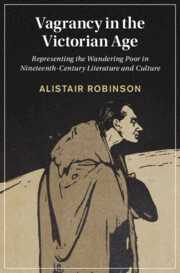 Vagrancy in the Victorian Age
Vagrancy in the Victorian Age Book contents
- Vagrancy in the Victorian Age
- Cambridge Studies in Nineteenth-Century Literature and Culture
- Vagrancy in the Victorian Age
- Copyright page
- Dedication
- Contents
- List of Illustrations
- Acknowledgements
- Introduction
- Part I The Country
- Part II The City
- Part III The Frontier
- Chapter 5 Paupers, Vagabonds and American Indians
- Chapter 6 Beachcombers
- Afterword: London 1902
- Bibliography
- Index
- Cambridge Studies in Nineteenth-Century Literature and Culture
Chapter 5 - Paupers, Vagabonds and American Indians
from Part III - The Frontier
Published online by Cambridge University Press: 02 November 2021
- Vagrancy in the Victorian Age
- Cambridge Studies in Nineteenth-Century Literature and Culture
- Vagrancy in the Victorian Age
- Copyright page
- Dedication
- Contents
- List of Illustrations
- Acknowledgements
- Introduction
- Part I The Country
- Part II The City
- Part III The Frontier
- Chapter 5 Paupers, Vagabonds and American Indians
- Chapter 6 Beachcombers
- Afterword: London 1902
- Bibliography
- Index
- Cambridge Studies in Nineteenth-Century Literature and Culture
Summary
Vagrants abound in the writings of British travellers who visited antebellum America. This chapter focuses on the representation of three of these vagrant figures. First, the pauper immigrant, a figure whose mobility was vigorously contested by British and American commentators. For the British these immigrants belong to the deserving poor – their rootlessness was temporary and incidental; for the Americans they were often perceived as undeserving vagrants and a potential financial burden. Second, the American Indian, a figure who was frequently compared to the English Gypsy, and whose nomadism was often repositioned as vagrancy and a sign of their impending extinction. And third, the American vagabond, a vagrant and anarchic figure who was represented as a lawless reprobate living on the frontiers. These three figures were interpreted using a range of representational strategies that were current in Britain, and together they demonstrate the flexibility of vagrant discourses – their ability to circulate globally as well as locally. Among other writers, this chapter examines the works of Frances Trollope, Harriet Martineau and Charles Dickens.
Keywords
- Type
- Chapter
- Information
- Vagrancy in the Victorian AgeRepresenting the Wandering Poor in Nineteenth-Century Literature and Culture, pp. 163 - 194Publisher: Cambridge University PressPrint publication year: 2021


